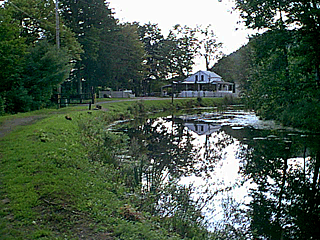 The water in what remains of the
Delaware and Hudson(D&H) Canal lies quiet and still now. Green trees
line the former towpath, making for a pleasant half-mile walk. At
one end a dam holds back the still waters in which tall reeds now
grow. The air is cool and fragrant from flowers growing on its
banks. The former canal house is now a restaurant.
The water in what remains of the
Delaware and Hudson(D&H) Canal lies quiet and still now. Green trees
line the former towpath, making for a pleasant half-mile walk. At
one end a dam holds back the still waters in which tall reeds now
grow. The air is cool and fragrant from flowers growing on its
banks. The former canal house is now a restaurant.
Nearby, the great Shawangunk conglomerate walls of former locks
create small canyons that filled with water to raise huge barges
filled with coal to the next level along the canal towards the town
of Kingston along the Hudson River in New York. Giant spikes, once
used to guide the tow ropes, protrude from the tops of the walls of
five locks near the picturesque village of High Falls, New York.
Large iron cleats, bolted to the top end of the walls once held the
doors of the locks. Each lock measured 90 feet long, 15 feet wide,
and 15 feet deep, and provided an average change in elevation of
12.6 feet.
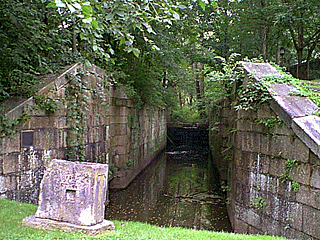 Originally built in 1847, these five locks were part of a new route
designed to accommodate increased traffic and larger boats on the
D&H Canal. The remains of a loading quay stand just past Lock 16.
Originally built in 1847, these five locks were part of a new route
designed to accommodate increased traffic and larger boats on the
D&H Canal. The remains of a loading quay stand just past Lock 16.
Canals like the D&H provided an easier method of transporting goods
around natural obstacles like rapids and waterfalls. They also made
it simpler to transport goods over higher ground. Originally,
setters used wagons to transport freight. In 1812, for example, it
took a six-horse team 18-35 days to transport 3,000 pounds of cargo
by wagon from Pittsburgh to Philadelphia. Though boat transportation
was faster, the route of the water limited travel by river. Canals
were the answer. More cargo could be shipped, and the time of the
journey reduced. The period between 1815 and 1835 witnessed more
than 3,000 miles of canals built in America.
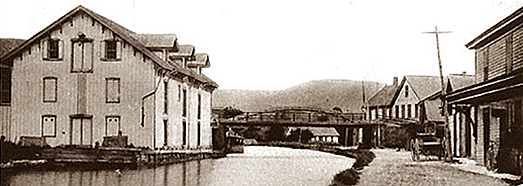
The D&H Canal established the first direct transportation link
between the Pennsylvania anthracite fields and New York City. The
War of 1812 had shut off the supply of bituminous coal from the
Britain, setting off America’s first energy crisis. Two enterprising
Philadelphia merchants, William and Maurice Wurts, purchased land in
the Lackawanna Valley cheaply from the U.S. Government in exchange
for debts incurred by it during the War of 1812.
In his spare time, William Wurts explored the new lands and
discovered blackish rock outcroppings of anthracite coal and began
mapping and researching them. He convinced his brother Maurice to
come along with him to see for himself.
T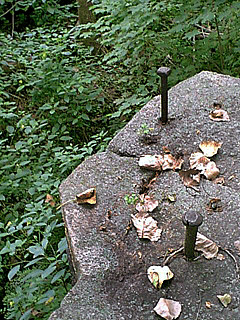 ogether they opened a small mining operation and at first wanted to
transport anthracite coal from it to Philadelphia, but coal from the
Schuylkill and Lehigh Valleys could be transported there more
cheaply, so they turned their attention to the New York market.
ogether they opened a small mining operation and at first wanted to
transport anthracite coal from it to Philadelphia, but coal from the
Schuylkill and Lehigh Valleys could be transported there more
cheaply, so they turned their attention to the New York market.
The success of the new Erie Canal inspired them. If they could build
a canal of their own from Pennsylvania to New York, through the
narrow valley between the Shawangunk Ridge and the Catskill
Mountains, to the Hudson River near Kingston, it could be
profitable.
n 1823, they lobbied the legislatures of both New York and
Pennsylvania to grant them a charter for the Delaware and Hudson
Canal Company. The company hired Benjamin Wright, engineer of the
Erie Canal, and his assistant John B. Jervis, to survey and plan a
route. At that time, Wright put the estimated cost at $1.2 million,
but later revised it to $1.6 million. The actual cost was closer to
$2.2 million. The Commonwealth of Pennsylvania kicked in some of the
money, but to raise the rest, the Wurts brothers needed to prove
that anthracite coal would burn better than bituminous coal. On
January 7, 1825, they convinced several business and financial
leaders to meet at the Tontine Coffee House on New York’s Wall
Street to watch anthracite burn. And burn it did. Within hours,
their freshly minted stock had sold out.
The Wurtses broke ground on July 13,1825. The company constructed
its canal along an unsettled route in less than three years using
only picks, shovels, draft animals, and blasting powder. It took
2,500 men and 200 teams of horses just to complete the section of
the D&H between Cuddebackville and Kingston, New York. Towns and
villages sprang up along its route.
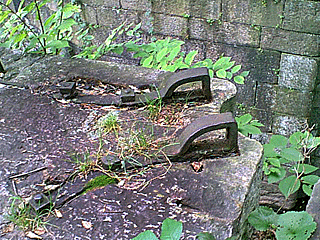 The canal opened to traffic in October 1828. It began at Rondout
Creek at an area later known as Creeklocks, between Kingston, where
the creek fed into the Hudson River, and Rosendale. From there it
proceeded southwest alongside Rondout Creek to Ellenville,
continuing through the valley of the Sandburg Creek, Homowack Kill,
Basha Kill and Neversink River to Port Jervis on the Delaware River.
It continued northwest on the New York side of the Delaware River,
crossing into Pennsylvania at Lackawaxen and running on the north
bank of the Lackawaxen River to Honesdale.
The canal opened to traffic in October 1828. It began at Rondout
Creek at an area later known as Creeklocks, between Kingston, where
the creek fed into the Hudson River, and Rosendale. From there it
proceeded southwest alongside Rondout Creek to Ellenville,
continuing through the valley of the Sandburg Creek, Homowack Kill,
Basha Kill and Neversink River to Port Jervis on the Delaware River.
It continued northwest on the New York side of the Delaware River,
crossing into Pennsylvania at Lackawaxen and running on the north
bank of the Lackawaxen River to Honesdale.
The finished canal ran 108 miles, from Honesdale to Kingston. Its
108 locks, each accommodating boats of up to 30 tons, raising or
lowering them between 8 and 12 feet, took it over elevation changes
totaling 1,075 feet, more than the 675 feet of the Erie Canal. The
channel was four feet deep, though the Wurtses eventually increased
it to six feet by 32 feet wide. Crossed by 137 bridges and had 26
dams, basins and reservoirs, it also crossed four rivers—the
Lackawaxen, Delaware, Neversink, and Rondout Creek—via slackwater
dams. And when the Wurtses enlarged the canal between 1847 and 1851,
they added four new aqueducts, engineered by John A. Roebling, the
architect of the Brooklyn Bridge.
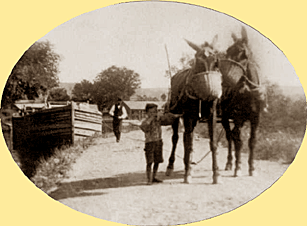 Mules pulled barges along a towpath that ran parallel to the canal
since the bow wave from a steamboat would have damaged the channel.
At first, the company hired children, called “hoggees,” to lead the
mules, but later on, they employed grown men to do the job. They had
to work 16-hour days, walking 15-20 miles, pumping out barges, and
tending the mules. For this, the company paid the children $1.25 a
month while the adults received $3.
Mules pulled barges along a towpath that ran parallel to the canal
since the bow wave from a steamboat would have damaged the channel.
At first, the company hired children, called “hoggees,” to lead the
mules, but later on, they employed grown men to do the job. They had
to work 16-hour days, walking 15-20 miles, pumping out barges, and
tending the mules. For this, the company paid the children $1.25 a
month while the adults received $3.
The Wurtses divided their canal into three sections—the Lackawaxen,
from Honesdale to the Delaware River, along the river from there to
Port Jervis, then the Neversink, from Port Jervis to Kingston. A
trip along its length initially took a week. There were no
operations on Sundays or on days in winter when the canal froze up
or was likely to.
Primarily, the canal transported coal and lumber from Pennsylvania
to the Hudson River. On the return trip to Pennsylvania, the barges
traveled empty. The company tried offering passenger service for the
first 25 years but gave it up when it proved unprofitable.
To get the anthracite from the Wurts' mine in the Moosic Mountains
near Carbondale to the canal at Honesdale, the canal company built
the D&H Gravity Railroad. On August 8,1829, the D&H's first
locomotive, the Stourbridge Lion, made history as the first
locomotive to run on rails in the United States.
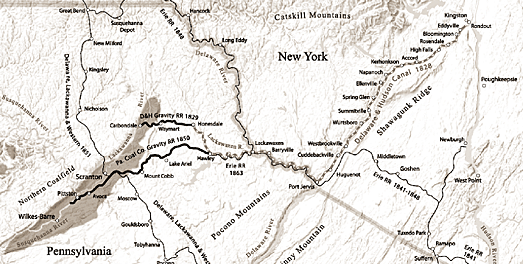
Business took off as the Wurtses had anticipated, and in 1832 the
canal carried 90,000 tons of coal and three million board-feet of
lumber.
Traffic increased on the canal In 1850, when the Pennsylvania Coal
Company(PCC) constructed its own gravity railroad from the coal
fields to the port at Hawley, carrying over 300,000 tons of PCC coal
in the first season. However, the relationship between the two
companies soured after the canal company attempted to raise tolls
under the argument that canal improvements had reduced costs for the
PCC. The dispute led to a court decision in 1863, but by that time
the Erie Railroad constructed its extension to Hawley, Pennsylvania,
and the PCC switched its shipments to the railroad.
The D&H also developed railroads to extend its reach into other
northeastern markets. It extended its gravity railroad from
Carbondale deeper into the coal fields and expanded its capacity. By
the time Maurice Wurts died in 1854, more than 1,400 boats were
operating on the canal.
By 1898, trains could carry coal more directly to New York City
across New Jersey rather than via Kingston via the new Delaware and
Hudson rail line. The following year the company dropped "Canal"
from its name.
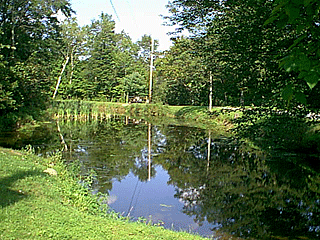 After the end of the 1898 season, the company opened all the waste
weirs and drained the canal. Catskill rail magnate Samuel Coykendall
purchased the canal the next summer, reportedly to use as a water
supply for the Ramapo Water Company. But that never developed.
Instead, Coykendall used the northernmost section, from Rondout to
Kingston, to transport Rosendale cement and other general
merchandise to the Hudson River until abandoning that business in
1904. The canal never saw traffic again.
After the end of the 1898 season, the company opened all the waste
weirs and drained the canal. Catskill rail magnate Samuel Coykendall
purchased the canal the next summer, reportedly to use as a water
supply for the Ramapo Water Company. But that never developed.
Instead, Coykendall used the northernmost section, from Rondout to
Kingston, to transport Rosendale cement and other general
merchandise to the Hudson River until abandoning that business in
1904. The canal never saw traffic again.
Besides its historical firsts, the canal stimulated the growth of
New York City. On the Pennsylvania end, the anthracite regions grew
from the rough wilderness they had been when William Wurts first
traveled them and mapped the coal deposits to a region of prosperous
coal mines and industries.
